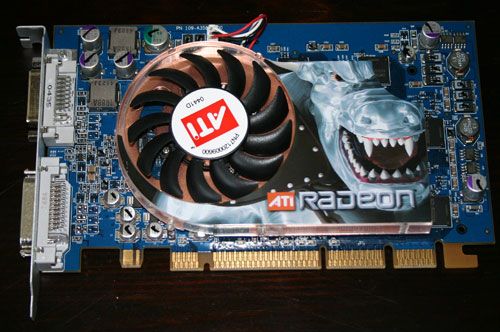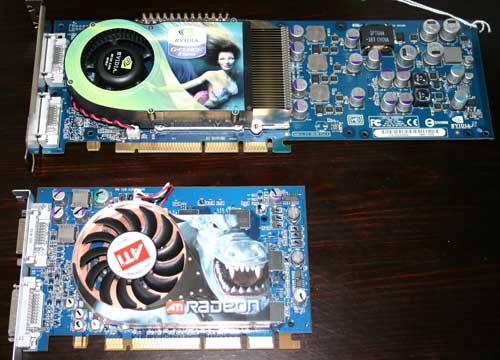ATI Radeon X800 XT Mac Edition: Competition in the Mac Market
by Anand Lal Shimpi on January 5, 2005 7:38 PM EST- Posted in
- Mac
In the PC world, ATI and NVIDIA duke it out every 6 months for retail sales and OEM customers. The Mac world is a little different, without tons of OEMs and a very small retail market, the ATI/NVIDIA battle is considerably less heated.
Apple, being the largest customer for Mac video cards, causes things to work a bit differently. While priding themselves on being quite secretive about future product plans, Apple does routinely share bits and pieces of their roadmaps with ATI and NVIDIA – detailing their graphics card needs for future notebooks and desktops. ATI and NVIDIA, in turn, pitch to Apple their forthcoming GPUs that would potentially meet the requirements of Apple’s roadmap.
Apple then decides which GPUs they want to use based on a variety of factors including, but not limited to, feature set, performance and price point. Apple also does their best to strike a balance between ATI and NVIDIA, so they never overly support one manufacturer over another.
Most recently the flagship GPU for Apple’s G5 line was ATI’s Radeon 9800 Pro Mac Special Edition, which was then replaced by NVIDIA’s GeForce 6800 Ultra DDL. Today, ATI is releasing into retail the first alternative to the GeForce 6800 Ultra DDL – the Radeon X800 XT Mac Edition.

Priced at $499, the 256MB X800 XT Mac Edition is a lower clocked version of the PC X800 XT. While the PC X800 XT runs at a 500MHz core clock with 1GHz memory, the X800 XT Mac Edition runs at a 475MHz core clock while keeping the same memory clock. The reason behind the lower core clock speed is simple, ATI’s not making a whole lot of X800 XT Mac Edition boards, so they want to make sure they are as high yielding as possible. In order to meet the $499 price point they had to slightly lower the core clock speed. We did promptly inform ATI that Mac folks don’t like their cards to be clocked lower than the PC equivalents but given the small clock difference, we’d much rather have a cheaper card.
Architecturally, the X800 XT Mac Edition is identical to the PC version (much like the 6800 Ultra DDL is architecturally identical to the PC version). For a better understanding of the architecture of the X800 XT Mac Edition and how it compares to the 6800 Ultra DDL please visit our original X800 article. Although it was reviewed from a PC perspective, the background architectural information remains the same.
The X800 XT Mac Edition is an AGP Pro 8X card (thus requires no external power), with one powered ADC port and one dual-link DVI port, the latter which is capable of driving the new 30” Cinema Display. The card uses the same cooling solution as the PC X800 XT, and ends up producing just as much noise as the GeForce 6800 Ultra DDL. Much like the PC version, the X800 XT is only a single slot, thus it leaves all of your PCI-X slots untouched.

NVIDIA's 6800 Ultra DDL is almost as long as Apple's keyboard
NVIDIA’s GeForce 6800 Ultra DDL on the other hand occupies two slots, and is significantly larger. On the flip side, the 6800 Ultra DDL is clocked at the same speeds as the PC 6800 Ultra, 400MHz core and 1.1GHz memory clock. The result is that the 6800 Ultra has a lower fill rate but more memory bandwidth than the X800 XT Mac Edition since they are both 16 pipe, 256-bit memory bus GPUs.

NVIDIA's GeForce 6800 Ultra DDL (top) vs. ATI's X800 XT Mac Edition (bottom)
While the GeForce 6800 Ultra DDL is priced at $599, NVIDIA also has a 6800GT DDL which runs at 350MHz core with 1GHz memory and is priced at $499. We weren’t able to secure a 6800GT DDL for testing today but we will be able to draw some conclusions based on the results today of how the X800 XT Mac Edition would stack up. In edition to the two new heavyweights we are also looking at the ATI Radeon 9800 Pro Mac Special Edition, ATI’s previous flagship part.










35 Comments
View All Comments
Eric5h5 - Thursday, January 6, 2005 - link
Yes, Halo does have FSAA, enabled either as an option at startup, or--more importantly--by using the ATI Override control panel. This is a big advantage over nVidia, at least on the Mac, since you can use various types and amounts of FSAA (and some other options like vsync and 16x AF) with any game, regardless of whether that option was originally programmed in or not. Very useful for older games, still often good for newer ones (especially since you can fiddle with options on the fly, while the game's running, as long as the game allows switching to the OS). All options don't necessarily work with all games, but usually they do.(The FSAA in Halo occasionally resulted in large slow-downs, but either the OS X 10.3.7 or the Halo 1.5 updates fixed that, at least on my 9600XT.)
Oh, and the human eye can see rather a lot more than 30 fps; let's not get into that again....
mlittl3 - Thursday, January 6, 2005 - link
#22, Lol!Cindy, you are such a love/hate sort of person. Just when I think you are a diehard Mac fan, you knock them down a little. I loved your comments on the last Mac article.
Anyway, I just wanted to ask one question. Are you reviewing graphics cards that are only available for purchase separately? Apple has been bundling the G5's with 9600xt's and 9800xt's for awhile now and I was wondering why they weren't included.
Also, the frame rates look a little low for these games compared to PCs. I'm sure this is because these games are heavily optimized for PC architecture instead of other's so any port to the Mac is not as heavily optimized.
Since this is the case, how about a more subjective review of Mac graphic cards and games. Instead of graphs with fps, why don't you just get a bunch of current games (and yes there are a bunch of games for the Mac) and look at image quality, playability and maybe even the ease (or difficulty) of playing multiplayer games in a PC/Mac mix of computers. Do they both connect using TCP/IP (I'm sure they do)? Do the Macs causing any lag while playing others on PCs, etc. etc.
There are more sides to a review on games with a certain computer hardware than graphs showing fps. The human eye can only see up to 30fps anyway, so let's look a little more a different titles and their playability while keeping an eye on which card "feels" better than the other.
With only a few cards available for the Mac, a comparison of which is faster is rather pointless anyway since each card has its own purpose outside of which is better for game frame rates. I.e., the 6800 DDL is for driving two 30" displays, the X800XT is good just for playing games with modern architecture (so you get a price break for not being able to drive two displays) and the 9800 pro (9600xt, 9800xt) is for the average power user who just wants the power of the G5 processors, Mac OS X and an upgradable tower (don't have this with the eMac, IMac, etc.).
Just my .02.
ViRGE - Thursday, January 6, 2005 - link
Good article Anand, especially where you talk about DDL and what makes these cards a bit different from their PC counterparts. I'm a bit flabbergasted that ATI did not make it 2xDDL though, since the Mac market does a lot more business with the kind of professionals that would need such a setup, than the PC market comparatively. I also second a2daj's comments about the benchmarks, they were more lacking than they needed to be. And what's up with a lack of FSAA testing? ATI's control panel lets you enable it wherever you want(unlike Nvidia, damn them), so it's not like it's too hard.PS What's up with ATI releasing this card now, instead of waiting a couple of weeks for MacWorld SF2K5? I would think his Steveness would want more new stuff to show off.
#22: The slot is an AGP 8x PRO slot; let me say this again, PRO slot. The slot has everything to do with it, as the Pro specification was designed so that cards could have extra power if they needed it. You're not entirely off base with your point about stubs(you do need another stub to hit the extra power pins of the Pro slot), but Apple isn't doing any strange Voodoo here, this is all part of a current AGP spec.
#18: With Halo and FSAA, my guess is that it has something to do with OpenGL. Whether the FSAA+Shader problem is only a Direct3D thing, or if it was a Halo problem fixed in the PC->Mac port I'm not sure, but by the sounds of it, FSAA can be done on the Mac.
CindyRodriguez - Thursday, January 6, 2005 - link
Anand says: "he X800 XT Mac Edition is an AGP Pro 8X card (thus requires no external power)"Nope. Not even close to correct. The fact that it's in an 8x slot has zero to do with why you don't need external power. The card, very visibly, has an additional power stub that corresponds with the extra power stub on the G5 motherboard. It's 28 V. I believe but I'd have to confirm that.
As for plugging it into a PC (which many people have asked about..) it will never run in a PC. As mentioned above, it uses a proprietary power stub not found on any PC motherboard. The stub is actually there to drive a monitor that may be on the ADC port but it also provides the extra power to that big, hungry GPU. It's not a bios issue.. It simply won't fit into a PC.
One last bit on this.. in typical Apple bone-headed fashion, (yes, I like Apple but they do stupid stuff occasionally).. Apple moved the power stub between the G4 and the G5. This card will ONLY run in a PowerMac G5.. not any other Macintosh.
cindy.
P.S. Thanks for perservering with the Mac reviews.. even if you aren't getting everything correct yet.
motoxpress - Thursday, January 6, 2005 - link
Another vote of appreciation for having this article. I also recommend you contact apple and get a copy of Motion for testing. It is a VERY good OpenGL killer ;)mx
MAValpha - Thursday, January 6, 2005 - link
Even if you reflashed the cards with their PC counterparts' BIOSes, I doubt they would work. As aliasfox already pointed out, the hardware is different. The TMDS transmitters are different, though I am still unclear as to whether or not there are twice as many, or whether each one simply has two signals running side-by-side. Either way, the graphics processor has to be able to communicate with its signal generators.eetnoyer - Thursday, January 6, 2005 - link
Perhaps you should start up an Irish version of your website for this sort of article: MacAnandtech.comOf course you probably wouldn't get many hits for it.
Sc4freak - Thursday, January 6, 2005 - link
Why was Halo tested with Anti-Aliasing? Halo doesn't support anti-aliasing as far as I know.MadAd - Thursday, January 6, 2005 - link
Man the size of that card is ridiculous - Nvidia remind me more and more of 3dfx these days.ksherman - Thursday, January 6, 2005 - link
"running two 30” Cinema Displays"**wonders in amazement**
Oh wait, I cant even imagine that! I can hardly fathom a single 30" display, let alone TWO!!!